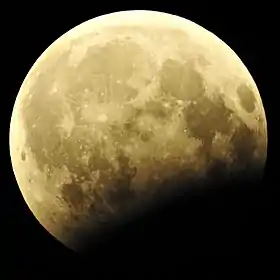April 1967 lunar eclipse
A total lunar eclipse took place on April 24, 1967, the first of two total lunar eclipses in 1967, the second being on October 18, 1967.[1]
| Total Lunar Eclipse April 24, 1967 | |
|---|---|
| (No photo) | |
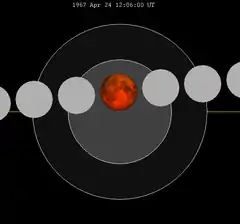 The moon passes west to east (right to left) across the Earth's umbral shadow, shown in hourly intervals. | |
| Series | 121 (53 of 82) |
| Duration (hr:mn:sc) | |
| Totality | 77 minutes, 56 seconds |
| Partial | 202 minutes, 48 seconds |
| Penumbral | 313 minutes, 24 seconds |
| Contacts | |
| P1 | 09:29:45 UTC |
| U1 | 10:25:02 |
| U2 | 11:27:28 |
| Greatest | 12:06:26 |
| U3 | 12:45:24 |
| U4 | 13:47:50 |
| P4 | 14:43:09 |
This lunar eclipse is first of a tetrad, four total lunar eclipses in series. The following tetrad is in 1985 and 1986, starting with a May 1985 lunar eclipse.
The Surveyor 3 probe landed on the moon during this eclipse.[2]
More details about the Total Lunar Eclipse of 24 April 1967.
Date = 24 April 1967
Penumbral Magnitude = 2.28924
Umbral Magnitude = 1.33559
Gamma = 0.29722
Greatest Eclipse = 24 April 1967 at 12:06:26.3 UTC
Ecliptic Opposition = 24 April 1967 at 12:03:24.0 UTC
Equatorial Opposition = 24 April 1967 at 11:51:47.1 UTC
Sun position
Right ascension: 2.09
Declination: 12.7
Moon position
Right ascension: 14.1
Declination: -12.5
Visibility
It was visible from Asia, Australia, Pacific Ocean, North America, South America and Antarctica.

Related lunar eclipses
Lunar year series
| Descending node | Ascending node | |||||
|---|---|---|---|---|---|---|
| Saros | Date Viewing |
Type Chart |
Saros | Date Viewing |
Type Chart | |
| 111 | 1966 May 4 |
Penumbral |
116 | 1966 Oct 29 |
Penumbral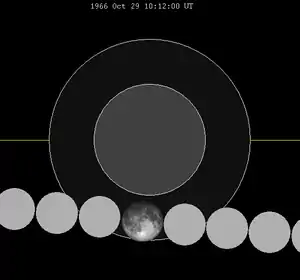 | |
| 121 | 1967 Apr 24 |
Total |
126 | 1967 Oct 18 |
Total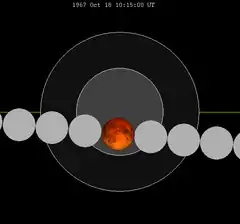 | |
| 131 | 1968 Apr 13 |
Total |
136 | 1968 Oct 6 |
Total | |
| 141 | 1969 Apr 2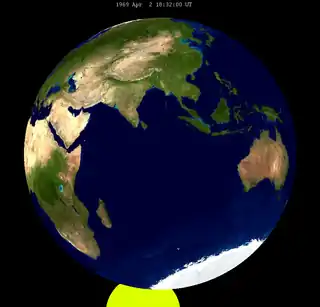 |
Penumbral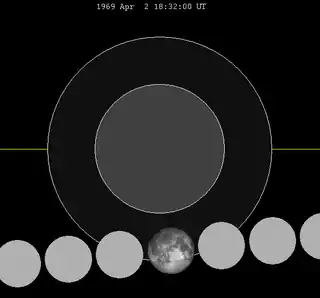 |
146 | 1969 Sep 25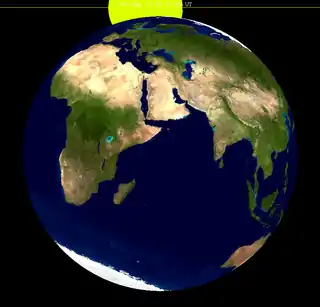 |
Penumbral | |
| Last set | 1965 Jun 14 | Last set | 1965 Dec 8 | |||
| Next set | 1970 Feb 21 | Next set | 1969 Aug 27 | |||
Tritos series
The tritos series repeats 31 days short of 11 years at alternating nodes. Sequential events have incremental Saros cycle indices.
This series produces 20 total eclipses between April 24, 1967 and August 11, 2185, only being partial on November 19, 2021.
| Tritos eclipse series (subset 1901–2087) | ||||||
|---|---|---|---|---|---|---|
| Descending node | Ascending node | |||||
| Saros | Date Viewing |
Type chart |
Saros | Date Viewing |
Type chart | |
| 115 | 1901 Oct 27 |
Partial |
116 | 1912 Sep 26 |
Partial | |
| 117 | 1923 Aug 26 |
Partial |
118 | 1934 Jul 26 |
Partial | |
| 119 | 1945 Jun 25 |
Partial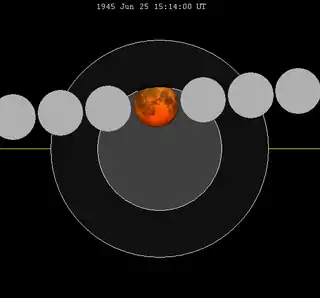 |
120 | 1956 May 24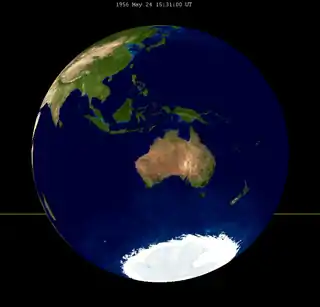 |
Partial | |
| 121 | 1967 Apr 24 |
Total |
122 | 1978 Mar 24 |
Total | |
| 123 | 1989 Feb 20 |
Total |
124 | 2000 Jan 21 |
Total | |
| 125 | 2010 Dec 21 |
Total |
126 | 2021 Nov 19 |
Partial | |
| 127 | 2032 Oct 18 |
Total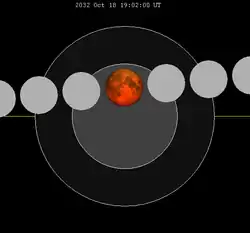 |
128 | 2043 Sep 19 |
Total | |
| 129 | 2054 Aug 18 |
Total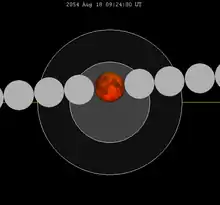 |
130 | 2065 Jul 17 |
Total | |
| 131 | 2076 Jun 17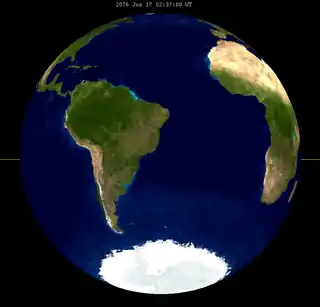 |
Total |
132 | 2087 May 17 |
Total | |
| 133 | 2098 Apr 15 |
Total | ||||
Metonic series
This eclipse is the third of four Metonic cycle lunar eclipses on the same date, April 23–24, each separated by 19 years:
The Metonic cycle repeats nearly exactly every 19 years and represents a Saros cycle plus one lunar year. Because it occurs on the same calendar date, the Earth's shadow will in nearly the same location relative to the background stars.
| Descending node | Ascending node | |||||
|---|---|---|---|---|---|---|
| Saros | Date | Type | Saros | Date | Type | |
| 111 | 1948 Apr 23.56 | Partial | 116 | 1948 Oct 18.10 | Penumbral | |
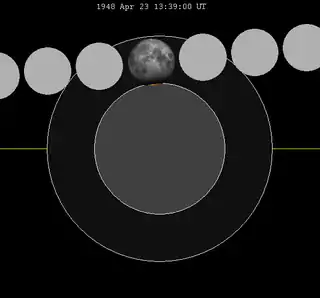 |
 | |||||
| 121 | 1967 Apr 24.50 | Total | 126 | 1967 Oct 18.42 | Total | |
 |
 | |||||
| 131 | 1986 Apr 24.52 | Total | 136 | 1986 Oct 17.80 | Total | |
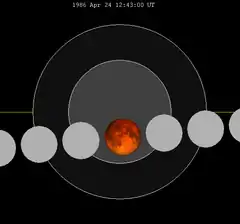 |
 | |||||
| 141 | 2005 Apr 24.41 | Penumbral | 146 | 2005 Oct 17.50 | Partial | |
 |
 | |||||
Half-Saros cycle
A lunar eclipse will be preceded and followed by solar eclipses by 9 years and 5.5 days (a half saros).[3] This lunar eclipse is related to two annular solar eclipses of Solar Saros 128.
| April 19, 1958 | April 29, 1976 |
|---|---|
 |
 |
See also
- List of lunar eclipses
- List of 20th-century lunar eclipses
Notes
- Hermit Eclipse: Saros cycle 121
- A Solar Eclipse from the Moon APOD 2014 April 7
- Mathematical Astronomy Morsels, Jean Meeus, p.110, Chapter 18, The half-saros
